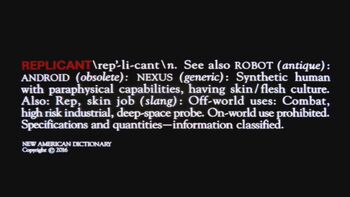|
| |||||

The definition given by the New American Dictionary[1]
A replicant was a synthetic, bio-robotic being with para-physical capabilities and designed to resemble a living, organic being. It was a genetically engineered being "composed entirely of organic substance" and marketed for labor by Tyrell Corporation and its successor, the Wallace Corporation.
Replicants were sometimes referred to as "skinjobs," as their likeness was often skindeep. The term was considered a slur.
History
A replicant was a bioengineered android composed entirely of organic material. The 'Nexus' series of replicants were virtually identical to adult humans, but had superior strength, speed, agility, resilience and intelligence to varying degrees depending on the model. These replicants were also programmed to live for a designated four years, an aspect that prompted a group of replicants to revolt and travel to the Tyrell Corporation to negotiate the terms of their designated life span.[2]
Some replicants were given away "free" to people accepting the offer to emigrate to the off-world colonies. Others were used in combat to protect colonists and explore other worlds (Zuben, Iggy Cygnus and Roy Batty were combat models). The Tyrell Corporation introduced the Nexus-6, the supreme replicant — much stronger and faster than, and virtually indistinguishable from, humans.[2]
After a bloody mutiny against an off-world colony staged by a Nexus-6 combat team in 2018,[3] the law forbade replicant existence on Earth, except in the huge industrial complex where they were created. The law did not consider replicants human and therefore accorded them no rights nor protection. Thus, special police units known as "Blade Runners" were established to hunt down and retire replicants.[2]
A replicant could be detected by means of the Voight-Kampff test, in which emotional responses were provoked; replicants' nonverbal responses differed from humans'. A key aspect of replicant psychology was that they are lacking in empathy, in effect making them textbook sociopaths. Nexus-6 replicants also had a safety mechanism, namely their four-year lifespan, to prevent them from developing empathic abilities (and, therefore, immunity to the test). This was especially necessary for Mental-A models whose intellectual capacity at least matched their designers. Due to their short lifespans, replicants had no framework within which to deal with their emotions, which led to them being emotionally inexperienced. Eldon Tyrell sought to change this by gifting replicants with a past through implanted memories and therefore creating an emotional cushion that would make them far more controllable. This vision led to the creation of Rachael, a replicant who was implanted with the memories of Tyrell's niece and believed herself to be human.[2]
According to Blade Runner Rick Deckard, a normal replicant could usually be discovered using the Voight-Kampff test, after being given twenty to thirty questions. Rachael answered over one-hundred questions before Deckard determined she was a replicant.[2]
Prompted by Tyrell's death in November 2019 at the hands of Nexus-6 Roy Batty, the Nexus-8 model was rushed onto the market in 2020 with open-ended lifespans and ocular implants for easy identification.[3]
In addition to her memory implants, Rachael was an experimental reproductive model of replicant, who ultimately conceived a daughter with Deckard. As she died during childbirth in 2021, of complications related to a caesarean section, it is uncertain if she could have lived beyond four years.[4]
Replicants were widely believed to be the cause of the Blackout in 2022.[3]
In 2023, an indefinite prohibition was placed on replicant production. By this time, all of the Nexus-6 models had been decommissioned due to their four-year lifespans. Surviving Nexus-8 replicants were ordered to be retired, prompting some to go into hiding.[3]
In the 2030s, after acquiring the remnants of the bankrupt Tyrell Corporation, Niander Wallace, with his company, the Wallace Corporation, improved upon Tyrell's replicants by making them obedient and able to be controlled. This led to the prohibition being lifted in 2036 and the introduction of the Nexus-9.[3]
Animal replicants (animoids) were developed first for use as pets and beasts of burden after most real animals became extinct.[2]
Behind the scenes
In his novel Do Androids Dream of Electric Sheep? (the basis of Blade Runner), Philip K. Dick used the term android (or "andy"), but director Ridley Scott wanted a new term that the audience would not have any preconceptions about. As David Peoples was re-writing the screenplay, he consulted his daughter, who was involved in microbiology and biochemistry. She suggested the term "replicating", the biological process of a cell making a copy of itself. From that, either Peoples or Scott—each would later recall it was the other—came up with replicant and it was inserted into Hampton Fancher's screenplay.[5]
The theatrical cut's voice-over ending states that as an experimental replicant, Rachael did not have the four-year life-span.
The super-soldiers in Soldier — the "spiritual successor" to Blade Runner — are intended to be replicants in the film.
M. Emmet Walsh contends that, during filming, the term "skinjob" was not considered bigoted, instead being simply slang for a replicant. The idea of it being a pejorative term originated with the theatrical version's voiceovers.[5] Additionally, the workprint version's definition of replicant refers to the term as slang.
References
- ↑ Blade Runner – workprint version
- ↑ 2.0 2.1 2.2 2.3 2.4 2.5 Blade Runner – all versions
- ↑ 3.0 3.1 3.2 3.3 3.4 Road to 2049 timeline
- ↑ Blade Runner 2049
- ↑ 5.0 5.1 Future Noir: The Making of Blade Runner – Revised & Updated Edition
